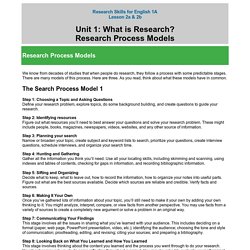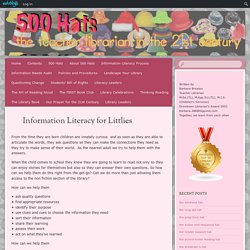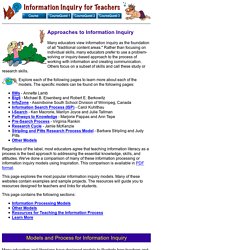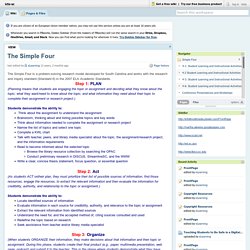

The Big 6 Model for Research. Mike Eisenberg Vodcast #4—The Role of the Teacher-Librarian and the School Library Program. Mike Eisenberg Vodcast #3—Accountability in the Information Literacy Program. Mike Eisenberg Vodcast #2—How to Implement an Information Literacy Program. Mike Eisenberg Vodcast #1—What is Information Literacy? Research Process Models. We know from decades of studies that when people do research, they follow a process with some predictable stages.

There are many models of this process. Here are three. As you read, think about what these models have in common. The Search Process Model 1 Step 1: Choosing a Topic and Asking Questions Define your research problem, explore topics, do some background building, and create questions to guide your research. Step 2: Identifying resources Figure out what resources you’ll need to best answer your questions and solve your research problem. Step 3: Planning your search Narrow or broaden your topic, create subject and keyword lists to search, prioritize your questions, create interview questions, schedule interviews, and organize your search time. Step 4: Hunting and Gathering Gather all the information you think you’ll need. Step 5: Sifting and Organizing Decide what to keep, what to leave out, how to record the information, how to organize your notes into useful parts.
Information Literacy for Littlies. From the time they are born children are innately curious and as soon as they are able to articulate the words, they ask questions so they can make the connections they need as they try to make sense of their world.

As the nearest adult we try to help them with the answers. When the child comes to school they know they are going to learn to read not only so they can enjoy stories for themselves but also so they can answer their own questions. So how can we help them do this right from the get-go? Can we do more than just allowing them access to the non fiction section of the library? How can we help them ask quality questionsfind appropriate resourcesidentify their purposeuse clues and cues to choose the information they needsort their informationshare their learningassess their workact on what they’ve learned to seek, evaluate, create and use information effectively to achieve their personal,. social, occupational and educational goals.
Research Process Livebinder USC-SLIS 742. Approaches to Information Inquiry. Models and Process for Information Inquiry Many educators and librarians have designed models to illustrate how teachers and learners act in information inquiry situations.

Other models have been developed for processes such as instructional design, thinking, and writing. During the 1980s educators and librarians experienced a surge of interest in information skills. At the peak of the HOTS (Higher Order Thinking Skills) movement, educators were finding that a process approach to information inquiry could be found across the curriculum. In 1985, Ann Irving discussed this idea of cross-curriculum connections in a book titled Study and Information Skills Across the Curriculum. Irving stressed a resource-based learning approach that emphasized addressing individual differences in teachng and learning style.
Icts-sc / The Simple Four. The Simple Four is a problem-solving research model developed for South Carolina and works with the research and inquiry standard (Standard 6) in the 2007 ELA Academic Standards.

Step 1: PLAN (Planning means that students are engaging the topic or assignment and deciding what they know about the topic; what they want/need to know about the topic; and what information they need about their topic to complete their assignment or research project.) Students demonstrate the ability to: Step 2: Act (As students ACT ontheir plan, they must prioritize their list of possible sources of information, find those resources, engage the resources, to extract the relevant information and then evaluate the information for credibility, authority, and relationship to the topic or assignment.)
Step 3: Organize (When students ORGANIZE their information, they make decisions about that information and their topic or assignment. Step 4: Reflect. Approaches to Information Inquiry. Big6 Resources.